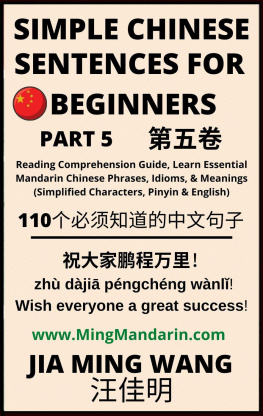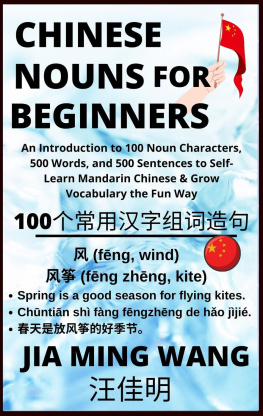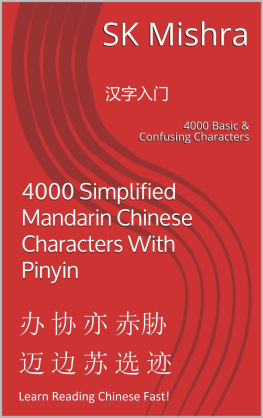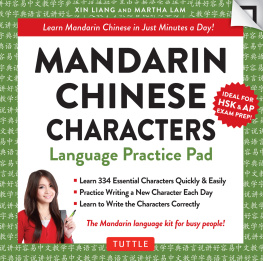Learn Chinese
A Comprehensive Guide to Learning Chinese for Beginners, Including Grammar, Short Stories and Popular Phrases
Copyright 2019
All Rights Reserved. No part of this book may be reproduced in any form without permission in writing from the author. Reviewers may quote brief passages in reviews.
Disclaimer: No part of this publication may be reproduced or transmitted in any form or by any means, mechanical or electronic, including photocopying or recording, or by any information storage and retrieval system, or transmitted by email without permission in writing from the publisher.
While all attempts have been made to verify the information provided in this publication, neither the author nor the publisher assumes any responsibility for errors, omissions or contrary interpretations of the subject matter herein.
This book is for entertainment purposes only. The views expressed are those of the author alone, and should not be taken as expert instruction or commands. The reader is responsible for his or her own actions.
Adherence to all applicable laws and regulations, including international, federal, state and local laws governing professional licensing, business practices, advertising and all other aspects of doing business in the US, Canada, UK or any other jurisdiction is the sole responsibility of the purchaser or reader.
Neither the author nor the publisher assumes any responsibility or liability whatsoever on the behalf of the purchaser or reader of these materials. Any perceived slight of any individual or organization is purely unintentional.
Table of Contents
Part 1: Chinese
Learn Mandarin Chinese for Beginners: A Simple Guide That Will Help You on Your Language Learning Journey
Introduction
Welcome to Chinese: Learn Mandarin Chinese for Beginners: A Simple Guide That Will Help You on Your Language Learning Journey ! This will be your first step toward success during the process of Chinese study.
There are only 10 chapters in this book. However, after learning these chapters, a solid foundation will be established both in pronunciation and basic knowledge of the Chinese language. In addition, you will also master some words and expressions for daily communication.
If you want to impress a future audience with your perfect spoken Chinese, a lot of time and effort while studying this book will need to be invested. Not only will you need to master the 3 basic elements of pronunciation (i.e. initials, vowels, and most importantly, tones), but you will also have to understand the sound change in certain circumstances.
Perhaps you may have heard people complaining that Chinese is difficult to learn. However, after studying this book, you will find that it is indeed not true. After finishing this book, you will easily master some Chinese expressions. A solid foundation is thus laid for advanced study in the future.
In addition to Chinese pronunciation, this book will also familiarize you with dialogue commonly used in daily communication. Examples include greeting, how to introduce yourself and other people, educational background, work, family, and friends, likes and dislikes, food and drink, and other common topics. You will have a sense of accomplishment after finishing these 10 chapters, because you will be able to speak quite a few idiomatic sentences which will enable you to have basic communications with native speakers. If you find that some translations in this book feel unnatural in English, we want you to note that weve used the literal method on purpose so that differences between the language systems can be stressed.
Chinese: Learn Mandarin Chinese for Beginners: A Simple Guide That Will Help You on Your Language Learning Journey is the key to entering the world of the Chinese language. We hope you find it fun and wish you success!
Chapter 1: Learning Chinese Tones
Among the components of a Chinese syllable, there is a tone besides the initial and the final. Generally speaking, one Chinese character corresponds to one syllable. A Chinese syllable can have no initials, but must have a final and a tone. Syllables with the same initials and finals but in different tones usually have different meanings.
Chinese has four main tones, as follows:
The main vocal characteristic of the first tone is high and flat. When it is articulated, the vocal cords are tightened up and the pitch is kept at a relatively higher level for a while. Lets see some examples so you can understand it better:
, cn ji, to take part in/to join
, jn tin, today
, sh f, sofa
, xing jio, banana
, s j, driver
, fn zhng, minute
, yng gi, should
, x cn, western food.
, gun x, relationship/in relation to
, chn tin, spring
, sh f, to express
, tng zh, notice/to inform
The second tone is a rising tone. It rises from the middle to a higher level while the vocal cords are gradually tightened up. Lets see some examples so you can understand it better:
, hu d, to answer
, j h, assemblage/to gather
, mng nin, next year.
, ln qi, basketball
, nin j, grade
, tng xu, classmate
, chfng, kitchen
, cng qin, in the past
, li xu, to study abroad
, yu j, post office
, yun li, turn out to be
, r tng, small child
The third tone is a dipping tone. The pitch goes from middle to low, then to high. Lets see some examples so you can understand it better:
, f do, to coach
, k y, should/sure
, lio ji, to understand
, shu bio, watch
. su y, therefore/so
, x zo, take a shower
, xio ji, Ms.
, y f, grammar
, y x, maybe/perhaps
, zh ho, have to
When the fourth tone is pronounced, the vocal cords are first tightened and then relaxed. The voice hence rapidly falls from the higher to the lower level. It is relatively easy to pronounce for most people. Lets see some examples so you can understand it better:
, b y, to graduate
, s sh, dormitory
, d gi, probably
, dun lin, to exercise
, yn dng, sport
, ji sho, to introduce
, hu bo, pictorial
, jio shu, professor
, qng zh, to celebrate
, j x, continue
, fn din, restaurant
, gu q, in the past/to come over
Intensive Practice
Now, lets practice with more vocabulary mixed by different tones.
1. First tone and second tone.
, dng rn, of course
, k xu, science
, fi chng, extremely/very
, gng ci, just now/a moment ago
, hun yng, welcome
, shng c, new vocabulary
, zhng wn, Chinese
, s rn, personal/ private
, jitng, home
, qng nin, youth
, jing li, future
, yo qi, requirement/to ask
, fng jin, room
, gu ji, country
, l ki, to leave
, mng tin, tomorrow
, tng w, roommate
, mo y, sweater
, ji hn, to get married
, sh jin, time
, ln j, neighbor
, zu tin, yesterday
, t go, to improve
, mo jn, towel
2. First tone and third tone.
, fng f, method
, shn t, body
, tng xi, dictation
, yng y, English
, bn zhng, monitor
, dng bi, northeast
, hi bn, blackboard









![Yi Ren - Mandarin Chinese for Beginners: Learning Conversational Chinese / Mastering Conversational Chinese [Book]](/uploads/posts/book/146887/thumbs/yi-ren-mandarin-chinese-for-beginners-learning.jpg)


